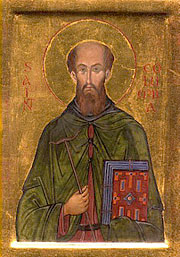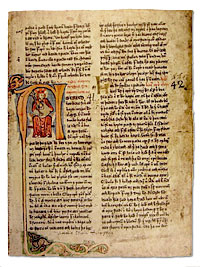ORTHODOX AMERICAOrthodox Christians in North America 1000 Years Ago by Priest Andrew Phillips
Although school children are no longer taught that Christopher Columbus discovered America, what they are not told - and what is not generally known - is that the first European to set foot on the New World was an Orthodox Christian, some five hundred years before the Roman Catholic Genoan. Who was he?
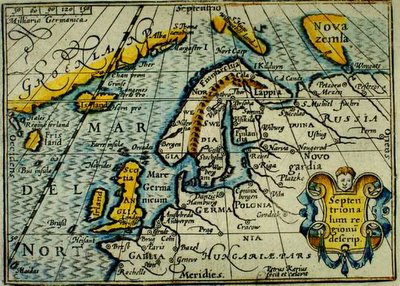
In the last two centuries of the first millennium, countries in northwest Europe and elsewhere became aware of peoples called Northmen or Vikings (from "viks" or "wicks," villages located on creeks or inlets in the cold, barren lands of Scandinavia). Setting sail in their distinctive high-prowed "long ships" in search of timber, fish and arable land, the Vikings acquired lasting notoriety with their savage attacks of peaceful countries. Their repeated onslaughts on England were particularly vicious. Martyring hundreds of monks and nuns, they put an end to the Golden Age of English Church culture.
Not all Vikings, however, were as bellicose. An eastern group, whom today we would call Swedes, were chiefly mercenaries and traders. They travelled widely to the east and south through Russia, where they founded the ruling Rurik dynasty,* to Constantinople. A third group, who inhabited what today is Norway, were traders and explorers, who travelled primarily westward. They settled in the hermit-occupied Shetland Islands and Orkneys. In northwest Scotland and England, in Wales and Ireland. In 870 they began colonizing Iceland where Irish monks, "papar," were already dwelling. Here Viking speech, Old Norse, has hardly changed in a thousand years, being preserved in the time-capsule of modern Icelandic. From here some were to move on to Greenland. The chief among these was Eric (Eirik) the Red. An outlaw like his father, he left Iceland in 982 and spent the next several years exploring the southwest coast of an ice-rimmed land he called Greenland in hopes of attracting settlers. He then led there a seven-hundred-strong expedition of emigrants. Their descendants were to occupy the land for five centuries, until they mysteriously disappeared in about 1500. To this Eric the Red we shall later return. Let us first speak of the Christianization of these Northmen.
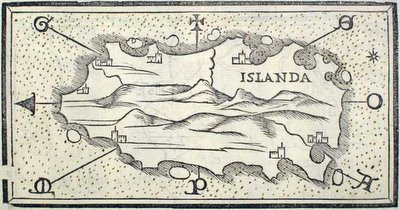
The Vikings were heathen, and they had their own dark and hopeless mythology of pagan gods and fates. Though their onslaught on Christendom led at first to bloodshed, the spiritually sensitive among them began to accept Christianity. By the end of the ninth century, the Danish Vikings who had settled in England after wreaking such havoc, had accepted the Faith at the hands of Alfred the Great. (It is notable that the Danish homeland itself did not accept Christianity until later still.) A century later the Swedish Vikings had begun to accept missionaries from England, whose presence is proved by, among other things, the Old English-style church of Saint Peter at Sgituna. Among the western Norwegian Vikings, the influence of English Christianity was greater still.
In 994 the leader of the Norwegian Vikings, Olaf Tryggvason, laid siege to London, famously destroying London Bridge. Olaf, however, had a change of heart and was chrismated and confirmed at Andover in the south of England by Alphege, Bishop of Winchester, the then English royal capital. When Olaf Tryggvason left England in 995, a new man, he took with him bishops and priests from Winchester and elsewhere in England, including a Bishop Grimkell, an Englishman of Danish origin, who was to become Bishop of the Norwegian capital at Nidaros, now called Trondheim. It was this mission which was to lead to the spreading of Christianity in Norway and the veneration there of such English saints as Saint Swithin of Winchester. In time, the Christian influence of Olaf Tryggvason spread to all future Norwegians, and outside Norway as well. Thus, the Icelandic Kristni Saga and the Saga of Olaf Tryggvason relate how, at his behest, the Christian faith was brought to the Norse settlers in Iceland in about the year 999. Such was the success of Christianity here that it is recorded that in about 1050 one Icelandic missionary, Thorwald, died in Kiev on a visit there. Let us now rejoin the saga of Eric the Red, the voyager and discoverer of Greenland, where our story begins in earnest.
One of the Norwegian Icelanders to join Eric the Red's expedition of settlers to Greenland, was a man called Herjolf. According to the Greenlanders' Saga, on board Herjolf's ship there was a Christian from the Hebrides who, sailing into the unknown, addressed the following prayer to Christ:
Master of monks, most pure, Thee
Do I beseech, shield my journey.
May the Lord of Heaven bless me
And stretch forth His hand upon me.
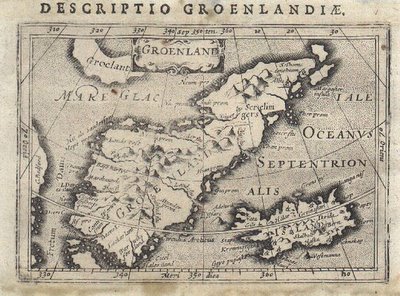
On arrival in Greenland, Herjolf made his home on a cape or "ness" not far from Eric the Red, who set up a farm in a place they called Brattahlid, "the steep slope."
This Herjolf had a grown son, Bjarni, who was a merchant. When Bjarni Herjolfsson returned to Iceland from Norway, where he had been on business, and discovered his father gone to Greenland, he decided to seek him out. It was the Year of Our Lord 986. Heading for Greenland but driven southwards by bad weather, Bjarni sighted land, wooded, not mountainous. Realizing that he had lost his way, he headed northwards, only to see a second land, flat and wooded, and then a third land with flat stony coasts and mountains of ice. Finally he arrived at the cape named after his father, Herjolfsnes, in the south of Greenland: Bjarni had sighted - but not landed in - new and unknown lands.
Herjolf's friend and guide, Eric the Red, had four Greenlander children: three sons - Leif, Thorvald, and Thorstein - and a daughter, Freydis. In 999 this first son, Leif Ericsson, "most excellent to look at, and in addition wise and moderate in everything as well as highly respected," set out from Greenland and went to Norway. There, while wintering at the royal court in Trondheim, he met King Olaf Tryggvason and, almost certainly, the English Bishop of Trondheim, Grimkell, whom we mentioned before. According to the sagas, King Olaf received Leif with much honor and, as a new Christian ruler, converted him to Christianity. According to the Saga of Olaf, "it was easy to baptize Leif," and Olaf assigned to him the task of converting the still heathen Greenlanders to Christianity.
The next spring, in the year 1000, Leif set out as a missionary to return to Greenland. He took with him a priest, perhaps one of the many English missionaries then at work in Norway, as well as "other holy men to baptize the people there and teach them the right faith." The Saga of Eric the Red records that on Leif's arrival at Brattahlid, his mother, Thjodhild, was baptized, and here they built the first church in Greenland. Leif and the "papa" or priest soon baptized most of the Greenlanders, and this first church was followed by some sixteen others, including a cruciform cathedral and also a monastery and a nunnery. The ruins of this first church were discovered and excavated almost a thousand years later, in 1961. It was a small wooden building, some twelve yards long and four wide, with turf walls, surrounded by sixteen graves.

Here in Greenland in 1001, Leif Ericsson first heard of Bjarni Herjolfsson's discovery of new lands to the southwest. This story moved him to buy a ship from Bjarni, with the idea of discovering for himself these new lands. What Leif's exact motives were we cannot say, but since Leif had been entrusted with bringing Christianity to Greenland, which he had done with the aid of clergy, his purpose may have been partly missionary. Thus it was, probably in the year 1002, that Leif Ericsson set out from Greenland with thirty-four companions and indeed discovered the same lands as Bjarni, but in reverse order, from north to south. First he found a coast of stone slabs beyond which rose glaciers, "mountains of ice." He called it "Helluland" (Flatstoneland). Then he saw a low, wooded land with white sand beaches, which he called "Markland" or "Woodland." Finally, two days further to the south, he came to another land of grass, pasture and woods, with a cape and very shallow bay, where their ship ran aground. The Norsemen took their ship up a creek into a small lake, near where they erected houses. They "gave the land a name in accordance with the good things they found in it, calling it Vinland" or "Vineland the Good," meaning, not "land of vines," as is often thought, but "land of meadows": "vin" in Norse means "meadow." Compared to Greenland it was a paradise for the Norsemen, for here they could pasture their cattle and drink fresh milk. Here they found wild grain and many berries from which they made bread and wine. They built "large houses" here and stayed the winter, seeing no snow.
On his return to Greenland the following spring, Ericsson found that his father was dying, and he assumed duties as the governor of the now numerous Greenland colony. The following year, 1004, his brother Thorvald sailed to "Leifsbudir," Leif's camp in Vinland. The next summer Thorvald explored the country to the west, with its woods, white sands and many islands. The summer after that, sailing east, he discovered a shallow cape that he called "Kjalarnes," "Keelness." On a headland to the east of there, Thorvald was killed in an affray with hostile "Skraelings" or "yellers" as the sagas called the natives on account of their loud war-cries. Before he died, Thorvald asked as a Christian that crosses be planted at the head and foot of his grave. These crosses were the first to be planted on American soil, and it is appropriate that this headland was called "Krossanes" (Crossness).

After the winter, Thorvald's crew returned to Greenland. A year later, in 1008, the third brother, Thorstein Ericsson, set out for Vinland but failed to reach it. In about 1020, the new husband of Thorstein's widow, an Icelander by the name of Thorfinn Karlsefni, sailing for two days with two ships, 140 people and livestock, went to Helluland and Markland, wintering near Keelness with its long beaches. It was there that a son, Snorri, was born - the first European to be born in the New World. His grandson was to become Bishop Thorla of Iceland. Karlsefni returned to Greenland with a cargo of furs which he had traded with the Skraelings and also Skraelings themselves, whom he had captured in Markland. These he had baptized - probably he had sailed with a priest - taught Norwegian and Norwegians had learned some Skraeling. Finally, after Leif's death in about 1020, Leif's sister, Freydis, visited Leif's original camp in Vinland with two ships in about 1024.
Further information about these early settlers is scant. In 1117, a Bishop Eric Gnupsson set sail for Vinland from Greenland, where he was papal legate, commissioned by Pope Pascal II to spread papal control of Scandinavia and the North. He stayed in Vinland, "that extensive and most wealthy country," for at least a year. As late as 1347 the Icelandic Annals indicate that there was some kind of Norse settlement in Markland. But beyond that, until further evidence proves otherwise, it is generally accepted that no permanent settlement was established there in Vinland, while the settlements in Greenland survived for about five hundred years.
It is only in the twentieth century that the truths of these Icelandic sagas and chronicles, as related above, have been interpreted and appreciated. From the precise directions, distances and descriptions given in the sagas, it is now clear that the Helluland of the sagas, the land of flat stones and glaciers, is Baffin Island, Canadian territory scarcely two hundred nautical miles from the closest point of Greenland. Markland, the flat land of forests, is Labrador. Keelness is Cape Porcupine, and, though once identified with areas as far south as Rhode Island and Cape God, Vinland itself must in fact be Newfoundland. This was confirmed by the startling find in 1960 of a Norse turf- and timber-built settlement at L'Anse-aux-Meadows near Cape Bauld on the northern tip of Newfoundland. Intensively researched by Dr. Helge Ingstad, the site was excavated by Norwegian archaeologists under the direction of Mrs. Anne Stein Ingstad, and carbon-dated to approximately AD 1000. The settlement remains suggest a large hall with four rooms, some eight other buildings up to twenty-five yards in length, including a bath-house and a smithy, as well as four boat sheds. One of the houses contained a slate-lined recess identified as an ember pit, similar to one excavated at Brattahlid. Norse artifacts were also found on the site. In 1964 a young Canadian helper unearthed a tiny soapstone wheel, a flywheel for a wool spinning spindle, evidence that the settlers did in fact include women. The same type of wheels have been found at Norse sites in Greenland, Iceland, and Norway. The architecture at L'Anse-aux-Meadows likewise corresponds to the very earliest buildings in Greenland; the lower walls are of turf, while the upper walls were probably of timber. Nearby are the ruins of two stone cairns - could they have once been standing crosses?
Although it cannot be stated of a certain on the basis of existent evidence, it is likely that this was the very site of Leif Ericsson's original camp, enlarged by those many who came after. Striking, too, is the very name of this settlement. "L'anse" is a French word meaning "inlet," "small bay," "creek"; and in Norse, the English word "meadow," as stated above, is "vin"; Vinland, the land of meadows, the pastureland. Nearby is a creek through which the Norsemen could have hauled their ship. It leads to a small lake which is surrounded by large meadows, beyond which there once stretched woods. Once Beothuk Algonquions lived here, but, massacred by French and English settlers, they became extinct in 1829. Were these not the "Skraelings" of Norse saga? The area around L'Anse aux Meadows is full of wild berries, cranberries, squash-berries (similar to grapes) and cloudberries, from which local people used to make wine. A type of wild grain, lyme grass, grows there and sometimes winters, made mild by the Gulf Stream, are virtually snow-free. We can imagine that a thousand years before, when the climate was milder, snow-free winters may have been the rule.
What became of these settlers? Did they all return to Greenland? Some think that they were decimated by disease. Others think it more likely that they intermarried with the "Skraelings." Reports from sixteenth- and seventeenth-century explorers like Champlain speak of white-skinned and fair-haired "Indians" with "wooden ships." Another hypothesis is that the settlers were killed by the aggressive Skraelings; we know that the settlement at L'Anse aux Meadows was burnt down, leaving today only low turf walls.
However we may look at it, the fact is that the first Christians in North America came from Scandinavia at a time when Scandinavian Christians were an integral part of Orthodox Christendom.
It is perhaps not idle speculation to wonder what might have been had these early Scandinavians settled in large numbers in North America. We can suppose that together with their priests and bishops they would gradually have moved further south towards more favorable climes, converting more native Americans along their way. Perhaps Christopher Columbus himself would have found here an already ancient native Orthodox Christian civilization, an Orthodox America. But history took a different turn. And so it is up to us to take up the mission begun in this land by Leif Ericsson and his Orthodox descendents.
Adapted from a longer article by Priest Andrew PhillipsFor further reading, see Orthodox Christianity and the English Tradition, Orthodox Christianity and the Old English Church, and The Tragedy of English History - all by Fr. Andrew Phillips..
Also: G. M. Gathorne-Hardy, The Norse Discoverers of America, 1921. H. Hermansson, The Problem of Wineland, 1936. R. A. Skelton et all., The Vinland Map and the Tatar Connection, 1965. Helge Ingstad, Westward to Vinland, 1969. Anne Ingstad, The Discovery of a Norse Settlement in America, 1977. Finn Gad, Groenlands Historie indtil 1700, 1978.
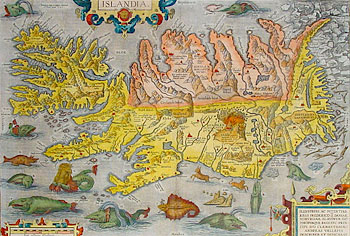
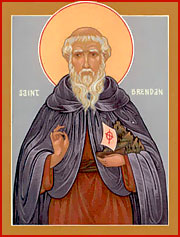
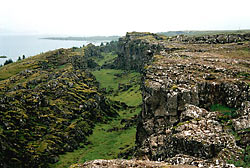 Но самое раннее упоминание о них относится приблизительно к 825 году, когда ирландский монах Дикуил, живший в то время во Франции, написал книгу «De mensura orbis terrae». В ней, упоминая об островах к северу от Шотландии и местоположении страны Туле, он сообщает о присутствия ирландских монахов в Исландии. За тридцать лет назад до того, в 795 году, когда Дикуил, вероятно, был еще в Ирландии, монахи поведали ему о своих путешествиях на дальний север. Отшельники рассказали об острове на севере Атлантики. Они сказали ему, что жили на острове, начиная с конца января до конца июля, и что летние ночи там — замечательно светлые; солнце заходит, но как будто лишь прячется за холм — остается так светло, что можно видеть и работать как при ясном дне. Можно предположить, продолжает Дикуил, что если на этом острове подняться на самую высокую гору, то можно будет увидеть, что солнце совсем не исчезает. Монахи также рассказывали, что вокруг этой страны — открытое море, но к северу от острова, на расстоянии дневного плавания, они встретили море замерзшее. Это самое раннее упоминание об Исландии, и оно подтверждает то, что сообщают нам позднейшие исландские письменные источники о поселившихся там ирландских пустынниках.
Но самое раннее упоминание о них относится приблизительно к 825 году, когда ирландский монах Дикуил, живший в то время во Франции, написал книгу «De mensura orbis terrae». В ней, упоминая об островах к северу от Шотландии и местоположении страны Туле, он сообщает о присутствия ирландских монахов в Исландии. За тридцать лет назад до того, в 795 году, когда Дикуил, вероятно, был еще в Ирландии, монахи поведали ему о своих путешествиях на дальний север. Отшельники рассказали об острове на севере Атлантики. Они сказали ему, что жили на острове, начиная с конца января до конца июля, и что летние ночи там — замечательно светлые; солнце заходит, но как будто лишь прячется за холм — остается так светло, что можно видеть и работать как при ясном дне. Можно предположить, продолжает Дикуил, что если на этом острове подняться на самую высокую гору, то можно будет увидеть, что солнце совсем не исчезает. Монахи также рассказывали, что вокруг этой страны — открытое море, но к северу от острова, на расстоянии дневного плавания, они встретили море замерзшее. Это самое раннее упоминание об Исландии, и оно подтверждает то, что сообщают нам позднейшие исландские письменные источники о поселившихся там ирландских пустынниках.